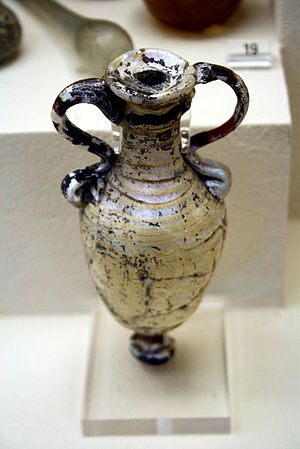Kaca Helenistik

Kaca Helenistik adalah kaca yang diproduksi pada zaman Helenistik, dari penaklukan Aleksander Agung (356-323 SM) sampai ekspansi Kekaisaran Romawi (paruh kedua abad ke-1 SM - 476) di Mediterania, Eropa, Asia barat dan Afrika Utara. Pembuatan kaca pada masa itu berdasarkan pada tradisi-tradisi teknologi Zaman Klasik dan Zaman Perunggu Akhir,[1] namun ditandai oleh transisi dari produksi terbatas dari barang-barang merah yang dibuat untuk kalangan elit menjadi produksi massal peralatan kaca yang dipakai oleh khalayak luas untuk memenuhi kebutuhan sehari-hari.[2]
Referensi[sunting | sunting sumber]
Bacaan tambahan[sunting | sunting sumber]
- Ashton, S.A., 2008. Ptolemaic and Roman Memphis as a Production Centre. In: Martinon-Torres, M. and Rehren, Th. (eds), Archaeology, History and Science; integrating approaches to ancient materials. Walnut Creek: Left Coast Press, CA, 101-115.
- Auth, S.H., 2001. Luxury Glasses with Alexandrian Motifs. Journal of Glass Studies 43, 39-44.
- Barag, D., 1985. Catalogue of Western Asiatic Glass in the British Museum, vol. I. London: British Museum Press.
- Cummings, K., 2002. A History of Glassworking. London: A&C Black.
- Fossing, P., 1940. Glass Vessels before Glass-Blowing. Copenhagen: Ejnar Munksgaard.
- Frank, S., 1982. Glass and Archaeology. London: Academic Press.
- Goldstein, S.M., 1979. Pre-Roman and Early Roman Glass in the Corning Museum of Glass, New York.
- Grose, D.F., 1981. Hellenistic Glass Industry Reconsidered. Annales du 8e Congres de l’ Association International pour l’ Histoire du Verre, 61-72.
- Grose, D.F., 1984. The Origins and Early History of Glass. In: Klein, D. and Lloyd, W. (eds), The History of Glass. London: Orbis Publications, 9-37.
- Grose, D.F., 1989. Early Ancient Glass; the Toledo Museum of Art. New York: Hudson Hills Press.
- Gudenrath, W., 2004. Techniques of Glassmaking and Decoration. In: Tait, H. (ed), Five Thousands Years of Glass (revised edition). London: British Museum Press, 213-241.
- Harden, D.B., 1956. Glass and Glazes. In: Singer, C., Holmyard, E.J., Hall, A.R. and Williams, T.I. (eds), A History of Technology, vol. II; the Mediterranean Civilizations and the Middle Ages. Oxford: Clarendon Press, 311-346.
- Harden, D.B., 1969. Ancient Glass, I: Pre-Roman. Archaeological Journal 125, 46-76.
- Harden, D.B., 1981. Catalogue of Greek and Roman Glass in the British Museum, vol. I. London: British Museum Press.
- Ignatiadou, D., 2002. Macedonian Glass-working in the 4th c. BC. In: Kordas, G. (ed), 1st International Conference: Hyalos, Vitrum, Glass; History, Technology and Conservation of Glass and Vitreous Materials in the Hellenic World. Athens, 63-70.
- Jennings, S., 2002. Late Hellenistic and Early Roman Glass from the Souks Excavations in Beirut, Lebanon. In: Kordas, G. (ed), 1st International Conference: Hyalos, Vitrum, Glass; History, Technology and Conservation of Glass and Vitreous Materials in the Hellenic World. Athens, 127-132.
- Nenna, M.D., 2002. New Research on Mosaic Glass: Preliminary Results. In: Kordas, G. (ed), 1st International Conference: Hyalos, Vitrum, Glass; History, Technology and Conservation of Glass and Vitreous Materials in the Hellenic World. Athens, 153-158.
- Rehren, Th., Spencer, L. and Triantafyllidis, P., 2005. The Primary Production of Glass at Hellenistic Rhodes. In: Cool, H. (ed), Annales du 16e Congres de l’ Association International pour l’ Histoire du Verre, Nottingham, 39-43.
- Romiopoulou, K., 2002. Glass Finds from Graves at Amphipolis. In: Kordas, G. (ed), 1st International Conference: Hyalos, Vitrum, Glass; History, Technology and Conservation of Glass and Vitreous Materials in the Hellenic World. Athens, 71-77.
- Shortland, A., Schachner, L., Freestone, I. and Tite, M., 2006. Natron as a flux in the early vitreous materials industry: sources, beginnings and reasons for decline. Journal of Archaeological Science 33, 521-530.
- Stern, E.M., 1999. Ancient Glass in Athenian Temple Treasures. Journal of Glass Studies 41, 19-50.
- Tatton-Brown, V. and Andrews, C., 2004. Before the Invention of Glassblowing. In: Tait, H. (ed), Five Thousands Years of Glass (revised edition). London: British Museum Press, 21-61.
- Turner, W.E.S., 1956a. Studies in Ancient Glasses and Glassmaking Processes; part III, the Chronology of the Glassmaking Constituents. Journal of the Society of Glass Technology 40, 38-52.
- Turner, W.E.S., 1956b. Studies in Ancient Glasses and Glassmaking Processes; part V, Raw Materials and Melting Processes. Journal of the Society of Glass Technology 40, 277-300.
- Triantafyllidis, P., 1998. New Evidence of the Glass Manufacture in Classical and Hellenistic Rhodes. In: Cool, H. (ed), Annales du 14e Congres de l’ Association International pour l’ Histoire du Verre, Venezia-Milano, 30-34.
- Triantafyllidis, P., 2002. The Art and the Craft of Glass in Southeast Aegean. In: Kordas, G. (ed), 1st International Conference: Hyalos, Vitrum, Glass; History, Technology and Conservation of Glass and Vitreous Materials in the Hellenic World. Athens, 21-39.
- Weinberg, G.D., 1983. A Hellenistic Glass Factory on Rhodes: Progress Report. Journal of Glass Studies 25, 37.
